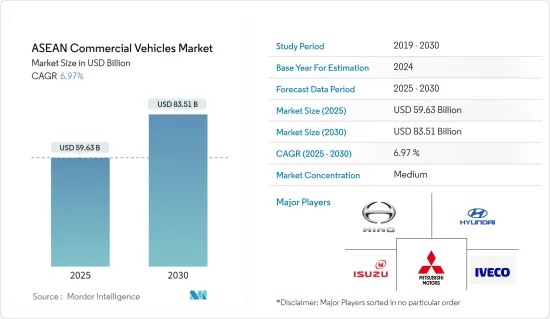
ASEAN의 상용차 시장 규모는 2025년 596억 3,000만 달러로 추정되며, 예측 기간 중(2025-2030년) CAGR 6.97%로, 2030년에는 835억 1,000만 달러에 달할 것으로 예측됩니다.

ASEAN의 상용차 시장은 인프라 정비의 진전, 보다 많은 물류차량을 필요로 하는 E-Commerce 활동 증가, 이 지역의 E-Commerce 유행으로부터의 경기 회복을 배경으로 2023년에 강력한 성장을 이루었습니다. 급속한 도시화와 대량 물자 이동의 필요성이 시장 환경을 개선했습니다.
장기적으로는 엄격한 자동차 배기 가스 규제, 자동차 안전성 향상, 신차에 ADAS(첨단 운전 지원 시스템) 도입, ASEAN 전역의 소매 및 E-Commerce 부문에서의 물류의 급성장이 주로 신형·선진 상용차 수요를 견인할 것으로 예상됩니다. LCV 수요는 물류 및 전자상거래 산업의 급성장에 따라 증가할 것으로 예상됩니다.
ASEAN 전역 정부는 디젤연료 연소로 인한 탄소 배출을 줄이고 온실가스 배출에 대처하기 위해 자동차 제조업체에 압력을 가하고 있으며, OEM은 전기 트럭 개발에 투자할 수 없는 상황에 있습니다.
1998년 이후 태국의 공해관리국(PCD) 규정에 따라 모든 신형 대형 트럭은 차량 공해를 억제하기 위해 유로 6 배기 가스 기준을 충족해야 합니다. 이 때문에 신형의 적합 상용차의 구입에 박차가 걸렸습니다.
전반적으로 ASEAN의 상용차 시장은 경제개척, 개인소비, 배출가스 관련 지속적인 정책조정을 통해 예측기간 동안에도 성장곡선을 그릴 것으로 예측됩니다.
인도네시아는 최근 ASEAN의 상용차 시장의 주요 국가로 부상했습니다. 이 성장은 몇 가지 중요한 요인 때문입니다.
이 나라의 강력한 경제 성장과 인프라 개발 증가는 다양한 부문에서 상용차에 대한 큰 수요를 촉진하고 있습니다. 새로운 유료 도로, 항만, 교통 허브 건설 등 정부의 의욕적인 인프라 정비 추진으로 대규모 대형 트럭과 건설 차량의 배치가 필요합니다.
게다가 인도네시아의 급성장 물류와 전자상거래 부문은 라스트원 마일의 배송을 촉진하는 소형 상용차(LCV) 수요를 크게 밀고 있습니다. 또한, 인도네시아의 상용차 시장은 국내 제조 및 차량 도입을 촉진하는 것을 목표로 하는 유리한 정부 정책의 혜택도 받고 있습니다.
게다가 인도네시아는 '에너지와 기후에 관한 주요 경제국 포럼(MEF)'의 목표인 2030년까지 세계의 중형·대형차 판매 대수의 30%를 제로·에미션 차(ZEV)로 한다는 목표에도 임하고 있습니다. 이 헌신은 운송 부문의 지속가능성과 탄소 중립에 중점을 둔 인도네시아의 자세를 반영합니다.
인도네시아 시장에서 사업을 전개하는 주요 기업은 이 나라 수요에 부응하기 위해 혁신적이고 선진적인 상용차의 투입을 가속화하고 있습니다.
ASEAN의 상용차 시장은 적당히 통합되어 있으며 시장을 크게 잡고 있는 기업은 소수입니다. ASEAN의 상용차 시장의 주요 기업으로는 Toyota Motor Corporation, ISUZU, Mitsubishi Motor Corporation, Hino Motors 등이 있습니다. 이 시장은 합작 투자, 파트너십, 산업 부문 수요 증가, 신흥 국가의 정부 개발 이니셔티브 등의 요인에 의해 크게 견인되고 있습니다.
예를 들어, Nex Point PLC(NEX)는 2022년 9월에 에너지 절약(EA) PCL과 협업하여 연간 생산능력 최대 9,000대의 태국 최초의 상용 EV 제조·조립공장 Absolute Assembly(AAB)를 설립한다고 발표했습니다. 이 회사는 3,195대의 전기 버스를 수주하여 200대의 납품에 성공했습니다.
The ASEAN Commercial Vehicles Market size is estimated at USD 59.63 billion in 2025, and is expected to reach USD 83.51 billion by 2030, at a CAGR of 6.97% during the forecast period (2025-2030).

The ASEAN commercial vehicle market saw robust growth in 2023, driven by rising infrastructure development, an increase in e-commerce activities requiring more logistics vehicles, and economic recovery from the COVID-19 pandemic in the region. Rapid urbanization and the need for mass material movement improved the market conditions.
Over the long term, stringent vehicle emission regulations, advancements in vehicle safety, the introduction of driver-assist systems in new vehicles, and rapidly growing logistics in the retail and e-commerce sectors across ASEAN are primarily expected to drive demand for new and advanced commercial vehicles. LCV demand is expected to rise as the logistics and e-commerce industries expand rapidly.
Governments throughout the ASEAN region are putting pressure on vehicle manufacturers to reduce carbon emissions from diesel fuel combustion and address greenhouse gas emissions, compelling OEMs to invest in developing electric trucks.
As per regulations of the Pollution Control Department (PCD) in Thailand since 1998, all new heavy trucks must meet Euro 6 emission standards to curb vehicular pollution. This spurred purchases of newer, compliant commercial vehicles.
Overall, the ASEAN commercial vehicle market is projected to continue its growth curve during the forecast period owing to economic development, consumer spending, and ongoing policy adjustments related to emissions.
Indonesia has emerged as the leading nation in the ASEAN commercial vehicle market in recent years. This growth can be attributed to several key factors.
The nation's robust economic growth and increasing infrastructure development have fueled significant demand for commercial vehicles across various segments. The government's ambitious infrastructure push, including the construction of new toll roads, ports, and transportation hubs, has necessitated the deployment of a vast array of heavy-duty trucks and construction vehicles.
Furthermore, Indonesia's burgeoning logistics and e-commerce sectors have driven substantial demand for light commercial vehicles (LCVs) to facilitate last-mile deliveries. Additionally, Indonesia's commercial vehicle market has also benefited from favorable government policies aimed at promoting domestic manufacturing and vehicle adoption.
Moreover, Indonesia has also pledged to the Major Economies Forum on Energy and Climate (MEF) objective of achieving 30% of global medium and heavy-duty vehicle sales as zero-emission vehicles (ZEVs) by 2030. This commitment reflects the country's focus on sustainability and carbon neutrality in its transportation sector.
The key players operating in the Indonesian market are increasingly launching innovative and advanced commercial vehicles to cater to the country's requirements.
The ASEAN commercial vehicle market is moderately consolidated, with few players having a significant hold of the market. Some of the key players in the ASEAN commercial vehicles market are Toyota Motor Corporation, ISUZU, Mitsubishi Motor Corporation, and Hino Motors. The market studied is highly driven by factors like joint ventures, partnerships, and growing demand from the industrial sector and government development initiatives across ASEAN countries.
For instance, in September 2022, Nex Point PLC (NEX) announced a collaboration with Energy Absolute (EA) PCL to establish Thailand's first commercial EV manufacturing and assembly plant, Absolute Assembly Co. Ltd (AAB), with an annual production capacity of up to 9,000 cars. The company received orders to produce 3,195 electric buses, with 200 units successfully delivered.